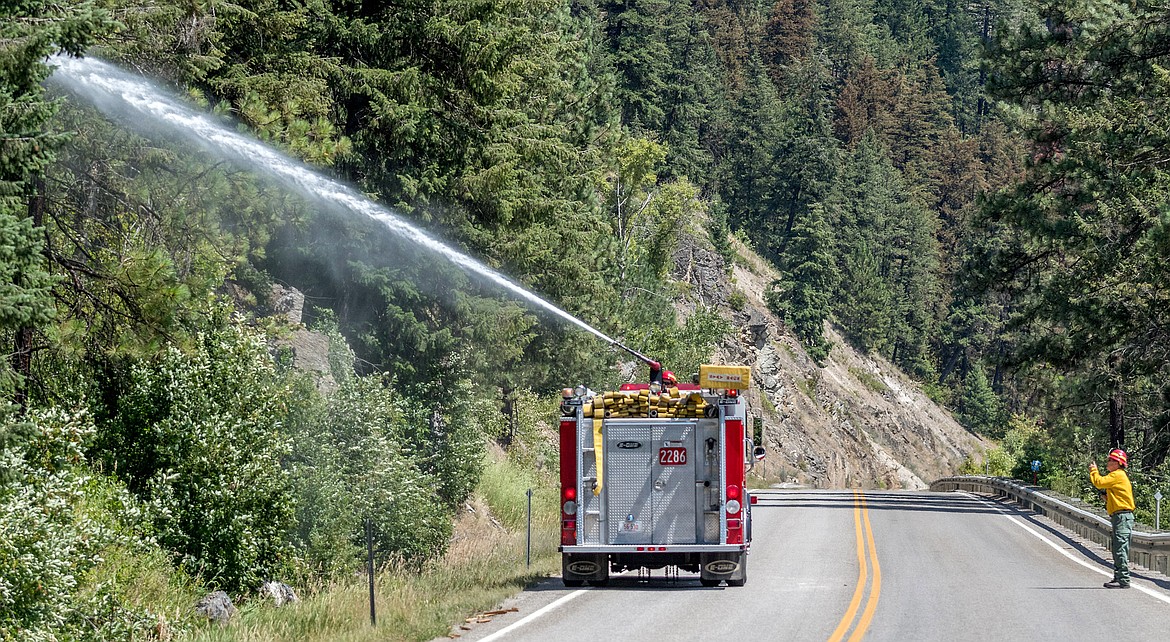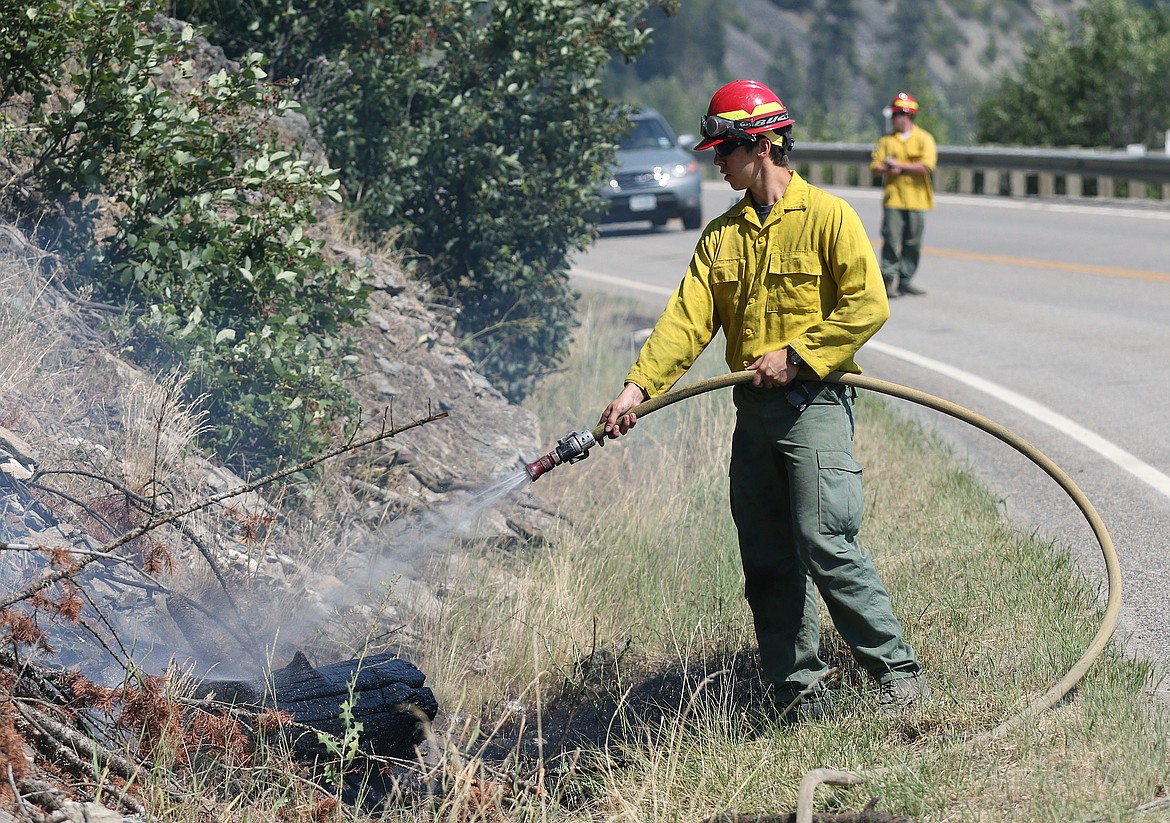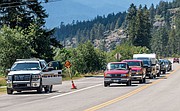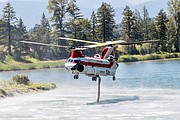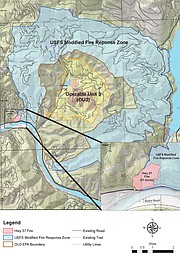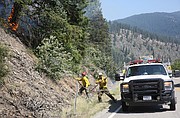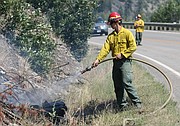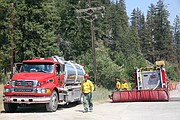Highway 37 fire Good weather, steady air attack limit spread, but risk remains
Favorable conditions and steady air support so far have helped control the Highway 37 fire north of Libby, but certain limited resources and upcoming hot, dry and windy weather mean firefighting could last a month.
“Even though it appears to be very docile at this point, and there’s not a lot of smoke, [the fire] will continue to creep ... under the surface of the ground out there as long as there’s organic matter,” Dean Whitney, a fire management officer with the U.S. Forest Service, said Monday morning.
Fuel conditions are “as dry or drier” than last year at this time, he said.
The fire, reported about 4 p.m. June 19, started on the north side of Highway 37 near mile marker 4. It spread quickly to 30 acres, potentially threatening power transmission lines and causing alarm for its proximity to the former W.R. Grace vermiculite mine.
Officials say the fire was caused by “discarded smoking material.”
Monday morning, Whitney said the fire was 51 acres in size and 10 percent contained. It still has “a lot of potential” to grow either by escaping its interior or due to “rollouts” of burning debris starting new fires, he said.
Libby Volunteer Fire Department and U.S. Forest Service firefighters on Thursday provided the initial attack from the ground, while about half a dozen helicopters and planes dropped water and retardant from above.
Meanwhile, two heavy dozers and two skidgens — a more nimble tracked vehicle with a smaller blade — were deployed to start building containment lines around the fire.
Firefighting resources have since remained steady, with helicopters regularly dropping water and Libby Volunteer Fire Department staging a fire engine, water tender and personnel to help a Forest Service handcrew respond to flare-ups and fires caused by rollouts — activities that occasionally required law enforcement to temporarily stop traffic.
Special response area
Steady as the resources have been, the ground response has been constrained due to most of the fire being inside a Modified Response Zone surrounding the Libby Asbestos Superfund site unit that contains the former W.R. Grace mine. The Forest Service established the zone in anticipation of fighting fires in the area, which the Environmental Protection Agency refers to as Operable Unit 3 (OU3).
The zone’s purpose is to address employee safety, according to Pamela Baltz, an environmental engineer with the Forest Service.
“We know that from past data there’s asbestos in the duff in that area, and because the asbestos concentrates in the ash we want to take extra precaution for our employees until we have further data,” Baltz said.
Where the asbestos concentrates in the ash, “it’s easily liberated during mop-up activities,” she said.
The Forest Service still awaits data from a small prescribed burn it conducted in the area in May that it hopes will provide a better picture of the exposure risks firefighters face in the area, Baltz said. The agency isn’t testing or monitoring during the Highway 37 fire, she said, because of the fire’s uncontrolled nature and the need to focus on firefighting and firefighter safety.
Fighting fires within the modified response zone requires special equipment, training and a series of decontaminating showers. Firefighters must wear respirators and work no longer than eight hours at a time, including decontamination.
Because the respirators add weight and limit how quickly a firefighter can breathe, “everything has to slow down,” Whitney said.
“We cannot do some of the regular practices that we would be doing on a standard fire outside of that modified response zone,” he said. “And we have a huge limitation on the amount of personnel that are trained and equipped to do that.”
The Forest Service currently has one 10-person contract crew qualified to perform the work, and about 20 to 25 other people who have similarly trained, Baltz said.
Because of the limited number of firefighters and the fewer hours they can work, “there will be a much longer than usual delay in accomplishing those tasks” that would take place outside the zone, Whitney said.
Despite the limitations imposed on fighting it, the Highway 37 fire is providing a vital experience as the first real-world implementation of the Libby Area Response Plan, a plan for fighting fires in and around OU3 that was finished last summer.
“We’ve learned a lot,” Whitney said. “There are definitely components of this plan that have never been exercised before. And I’m very optimistic with the group of folks that are on that contract crew helping us out. They’ve performed very well, especially considering the restrictions of wearing the [respirator].”
A 20-person Forest Service handcrew has been fighting the fire outside the modified response zone.
Aside from the special response requirements, Whitney said there is nothing unusual or uncommon about the Highway 37 fire.
The coming days
Whitney said the forecast for Wednesday night through Friday night is hot, dry and windy weather with “a tiny amount of moisture.”
“A firefighter like myself reads that as a possibility of thunderstorms with lightning,” he said. “And when a chance of wetting rain is zero to low, that means we’ve got higher probability of dry lightning, so we’re gearing up for that.”
As part of that preparation, the Forest Service moved the Highway 37 fire command post from the fire cache across from the J. Neils Park entrance to Lincoln County Rural Fire District Station 2.
“That’s closer to the fire and makes us more readily available for initial attack responsibilities for the rest of the district,” he explained.
Whitney noted that fire containment can be “a real hard thing to gauge and get people to understand.”
“Just having a line around the fire doesn’t mean it’s contained, because we like to secure from the outer perimeter inwards, usually by mopping up, and so that’s not just hammering it with water from air resources,” he said.
Mopping up includes digging out stumps, turning over logs and turning up the duff and mixing it with moisture, he said.
“[Right now,] it looks very good, especially from a distance, but there’s a lot of the fire that folks can’t see under the canopy of the trees that’s still active at the surface level,” Whitney said. “The fire will still have potential until it is thoroughly mopped up.”


